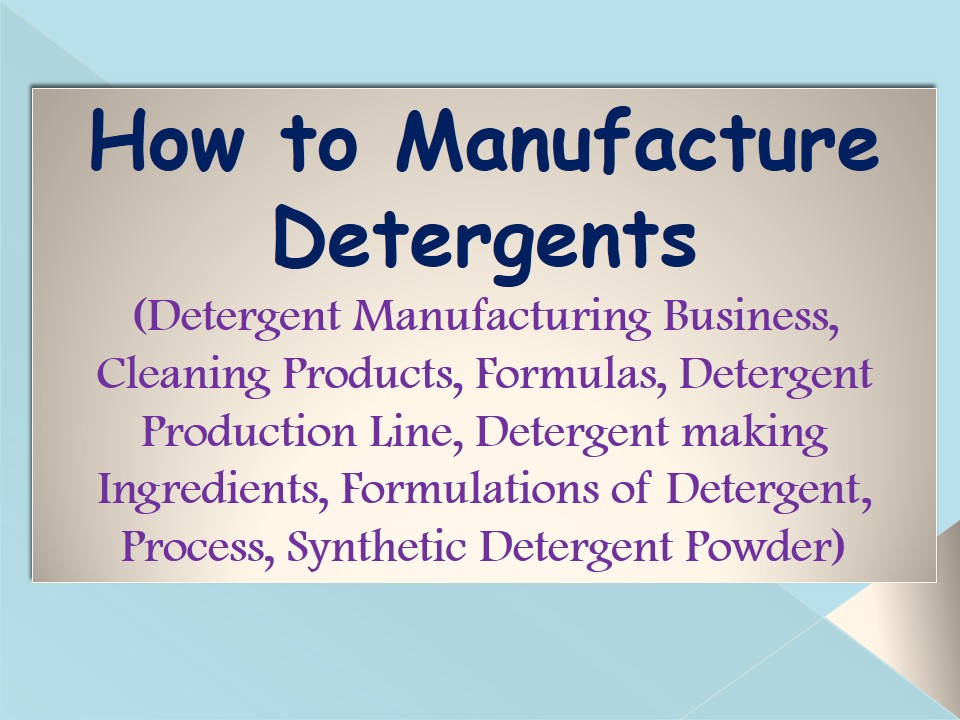
Starting a detergent manufacturing business can be a profitable venture with growing demand from households and industries alike. Detergents are essential items for daily cleaning, and entrepreneurs can leverage this demand to launch scalable and successful enterprises. However, to ensure success, you must carefully plan, understand formulations, and comply with legal requirements.
Understanding the Detergent Manufacturing Industry
The global cleaning products market is expanding, especially in emerging economies where hygiene awareness is increasing. This makes the detergent manufacturing business an excellent opportunity for entrepreneurs. It requires moderate investment and offers significant growth potential through retail and bulk supply chains.
See Also : Architects Directory
Types of Detergents You Can Manufacture
To begin with, it’s important to decide what type of detergents your business will produce. There are several types, and each requires specific formulations and processes:
1. Powder Detergents
Powder detergents are widely used in homes and laundries. They are cost-effective, have a longer shelf life, and are easy to transport. The production involves mixing various ingredients like surfactants, builders, fillers, and enzymes.
2. Liquid Detergents
Liquid detergents are gaining popularity due to their ease of use and better solubility. They are suitable for both manual and machine washing. The manufacturing process includes blending liquid surfactants, stabilizers, fragrances, and water.
3. Cake Detergents
Detergent cakes are primarily used in rural or semi-urban areas. Their production involves mixing powder ingredients with binders and molding them into solid bars. They are usually cheaper than liquid or powder detergents.
4. Specialty Detergents
These include products for dishwashing, industrial cleaning, or baby clothes. Entrepreneurs in the detergent manufacturing business can target niche markets for higher margins.
Raw Materials Needed for Detergent Production
Before starting production, ensure a consistent supply of raw materials. The most common ingredients include:
-
Surfactants (e.g., linear alkylbenzene sulfonate)
-
Builders (e.g., sodium tripolyphosphate)
-
Fillers (e.g., sodium sulfate)
-
Enzymes and optical brighteners
-
Color and fragrance
-
Stabilizers and preservatives
Each type of detergent has a unique blend of ingredients based on its usage and performance expectations.
Detergent Manufacturing Process Explained
The production process can be manual, semi-automatic, or fully automated depending on the scale. Here are the major steps involved:
1. Mixing and Blending
Raw materials are mixed in a batch mixer or ribbon blender to ensure even distribution. Surfactants are carefully added and blended to maintain uniformity.
2. Drying or Forming
For powder detergents, the mix is dried using spray drying or air drying. In case of detergent cakes, the mixture is pressed into molds. Liquid detergents are filled directly into bottles or pouches.
3. Quality Testing
Samples are taken for quality control. Parameters like pH level, foaming capacity, dirt removal efficiency, and skin compatibility are checked.
4. Packaging
Packaging is crucial in the detergent manufacturing business. Detergents are packed in pouches, bottles, or cardboard boxes with moisture barriers. Attractive packaging improves shelf appeal and customer confidence.
Machinery and Equipment Required
To start the business on a medium scale, the following machines are essential:
-
Sigma mixer or ribbon blender
-
Weighing scales and measuring tanks
-
Triple roller mill for cake manufacturing
-
Packaging machines for pouch or bottle filling
-
Spray dryer (for large-scale powder detergent plants)
Initially, you can opt for semi-automatic setups to minimize costs. As demand grows, automation can be gradually integrated.
Formulation and Testing: A Critical Step
One of the most critical steps in the detergent manufacturing business is developing the right formulation. The blend should clean effectively without damaging fabric or skin. It must also be compatible with hard and soft water. Many entrepreneurs partner with chemical consultants or hire formulators to ensure their product meets market standards.
Additionally, regulatory bodies often require certifications related to safety, toxicity, and environmental impact. Hence, testing formulations in accredited labs is strongly recommended before mass production.
Legal Requirements and Business Registration
To legally operate a detergent manufacturing business, you must register the company under your state’s industrial development laws. Additionally, you need:
-
GST registration
-
Factory license (for medium or large units)
-
Pollution control board clearance
-
Trademark registration (for brand protection)
-
BIS certification for certain detergent grades
Complying with these norms ensures a hassle-free business operation and builds trust among distributors and consumers.
Location and Infrastructure Setup
Choosing the right location helps streamline operations. Look for an industrial zone with easy access to raw materials, transport facilities, and utilities like water and electricity. The factory layout must include sections for raw material storage, mixing, packaging, finished goods, and waste handling.
Proper ventilation, drainage, and worker safety measures should be part of the infrastructure. Even small-scale detergent manufacturing units must follow basic hygiene and safety regulations.
Branding and Marketing Strategy
Even with a great product, success depends on your branding and marketing efforts. In the detergent manufacturing business, competition is stiff with many established players. So how can you differentiate?
-
Create a unique brand name and logo
-
Highlight USPs like bio-degradable, hypoallergenic, or child-safe properties
-
Use social media, eCommerce, and traditional retail to build presence
-
Offer free samples or trial packs for customer testing
-
Establish retailer and wholesaler networks with attractive margins
Strong marketing helps you penetrate both urban and rural markets. Moreover, packaging design and quality play a big role in customer preference.
Investment and Profit Potential
The initial investment depends on the scale of the detergent manufacturing business. For a small-scale setup, ?10–15 lakhs may be sufficient. This includes equipment, raw materials, labor, and licensing. A medium-scale plant may require ?25–40 lakhs. However, margins are healthy with 20–35% profits possible.
Return on investment can be achieve within 12–18 months if proper marketing and quality control are maintaine. The recurring costs are limit to raw material procurement, packaging, utilities, and labor, which can be efficiently manage over time.
Environmental Responsibility and Waste Management
With increasing environmental regulations, the detergent manufacturing business must adopt eco-friendly practices. These include:
-
Using biodegradable surfactants
-
Recycling wastewater
-
Avoiding phosphates and harmful chemicals
-
Using recyclable or biodegradable packaging
Not only do such steps reduce regulatory risks, but they also appeal to environmentally conscious consumers. Therefore, integrating sustainability from the beginning is both wise and rewarding.
Export Opportunities in Global Markets
Once the domestic business stabilizes, consider exploring export potential. Several developing nations have growing demand for cost-effective detergents. You can partner with export houses or register under export promotion councils to gain access to foreign markets. International branding can fetch better prices and increase profits substantially.
See Also : Indian SME Directory
Conclusion
The detergent manufacturing business offers a profitable entry into the fast-moving consumer goods sector. With moderate investment, scalable operations, and increasing demand, entrepreneurs can build a sustainable and growing enterprise. By focusing on quality formulations, effective branding, and legal compliance, your venture can stand out in a competitive market. The key is to start small, maintain consistent quality, and expand gradually based on demand.





